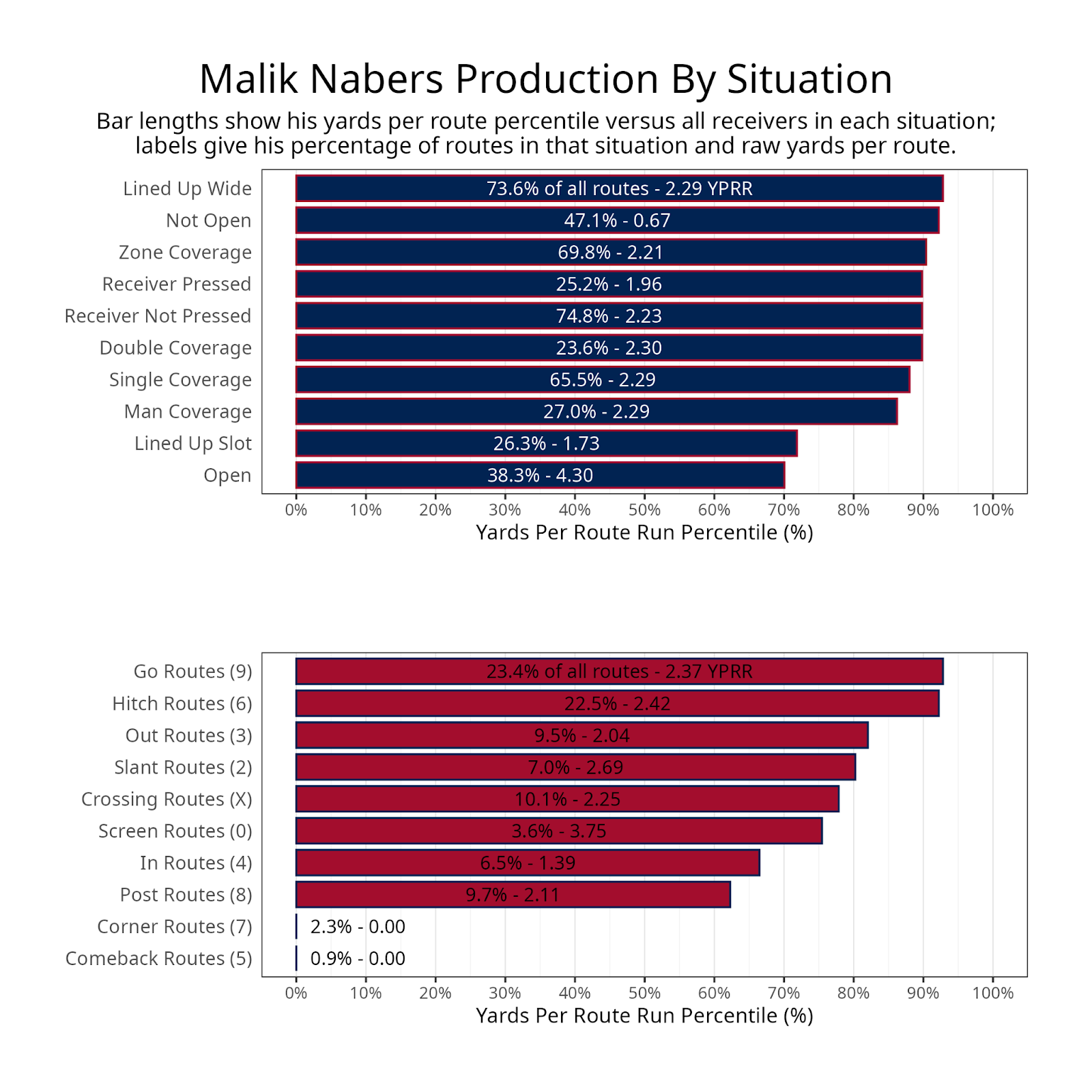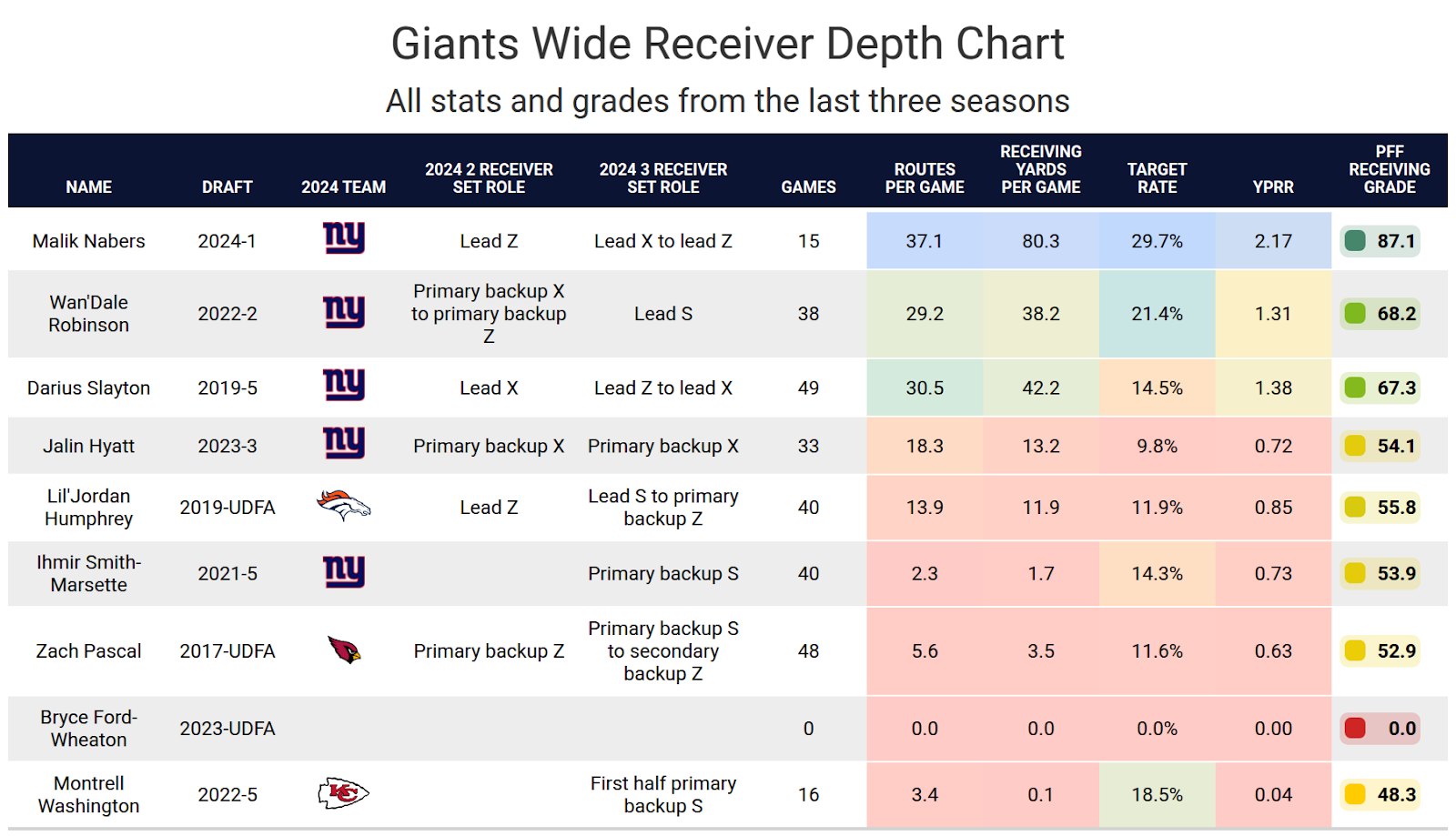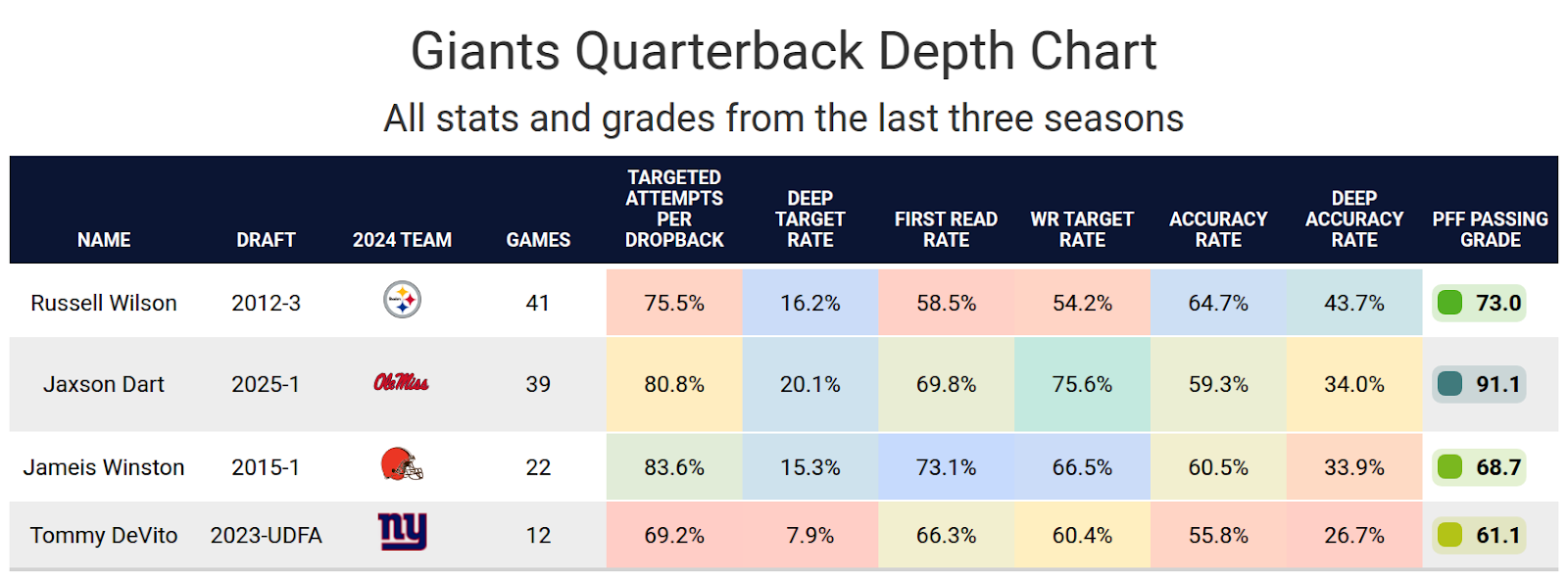- Malik Nabers lived up to expectations: Nabers was drafted to be the new start of the New York Giants offense, and he was the clear best player on the unit last season.
- Russell Wilson will change the offense: Wilson is a more accurate passer than the Giants' quarterbacks of last season, but he also checks down more than the Giants' quarterbacks did last year.
- Subscribe to PFF+: Get access to player grades, PFF Premium Stats, fantasy football rankings, all of the PFF fantasy draft research tools and more!
Estimated Reading Time: 5 minutes
PFF’s Fantasy Football Player Profile series delivers the most in-depth fantasy football analysis available for the 2025 season.
Using PFF’s exclusive data, we evaluate player performance, competition for touches and how teammates and coaching staffs will impact each player's fantasy football outlook.
Last updated: 7:15 a.m. Friday, May 9
Click here for more draft tools:
NFL Draft Big Board | Mock Draft Simulator | NCAA Premium Stats
2025 PFF Draft Guide | Mock Draft Hub | Prospect Data Profiles
Draft Position Rankings
Player performance
Malik Nabers was the sixth overall pick of the 2024 NFL Draft with lofty expectations. He instantly began living up to the hype, finishing with over 100 yards in two of his first four games and three touchdowns during that stretch. He proceeded to miss two games due to injury. From Weeks 7 to 18, he averaged 16.5 PPR points per game, 12th-best.
He ranked around the 90th percentile in most situations for wide receivers. He was targeted on 29.7% of his routes, first among 72 wide receivers who ran at least 355 routes last season. That equated to a league-leading 11 targets per game. The elite volume and very good quality of play added up to the seventh-most fantasy points per game last season.
The high target rate helped him have a very high floor, scoring a minimum of eight PPR points in every single game. However, that also meant he didn’t have many games with a high ceiling. After returning from injury, he only had one game above 85 receiving yards.


Projected role
The Giants had the fourth-lowest team receiving grade last season but surprisingly made few changes to the offense. At wide receiver, the top four players of the depth chart remained the same. They added three free agents from other teams, but at most, one will make the roster, and there is a chance none will. They similarly made no changes to their tight end room outside of a seventh-round pick.
Even the offensive line, which ranked in the bottom 10 in both run- and pass-blocking grade, appears to have the same five players as last season. Nabers' usage and competition for targets should remain very similar to last season. There’s a chance the running backs see more targets this year, or another receiver steps up more from the previous year, but Nabers is a clear favorite to be among the top players in targets for another year.


Impact of teammates
Nabers will have Brian Daboll as his head coach for another season. He’s had a history of running with the ball but was more pass-heavy last season than in previous years. That was likely due to losing Saquon Barkley while gaining Nabers. There is a chance they return to being even more run-heavy with Cameron Skattebo as an option at running back.
The biggest change for Nabers is at quarterback, where Russell Wilson is expected to be the starter. There is a chance Jaxson Dart, or even Jameis Winston, will win the job at some point, but the general expectation is Wilson will start for most, if not all, of the season.
This should lead to more accurate passes. The Giants quarterbacks had a 59.2% accuracy rate, which ranked 21st-best among teams. Russell Wilson had the third-best accuracy rate last season at 68.0%. However, this could also lead to fewer targets for Nabers. The Giants had a 71% first-read target rate last season, the third-highest among teams. Nabers was the first read on a high percentage of plays, so that combination helped him to a dominant target total. Over the last three seasons, Wilson’s first-read rate is the lowest among quarterbacks who have started more than one season. Other quarterbacks on the roster would be more likely to focus on Nabers.
One thing all three quarterbacks have in common is that they throw deep at a high rate. The quarterbacks in New York last season all had an average to low rate of throwing deep. Nabers was tied for the sixth-most deep targets at 29 last season but only caught seven. Even if he sees a lower target rate, he should catch more deep passes this season, which should help him have more big games this season.
In order for Nabers to reach the top few fantasy wide receivers, the team simply needs to play better. They were among the worst teams in points per game the last two seasons, and while they made a change at quarterback and running back, that might not be enough for a significant improvement.


Bottom line
Nabers was a top-10 wide receiver in fantasy last season, and we should expect more of the same. He had a relatively high floor and low ceiling when compared to other elite receivers last season. That should change this season due to fewer targets thanks to Russell Wilson’s tendency to check down and more big plays thanks to Wilson’s high deep target rate.

Footnotes
- Statistics in tables and charts were chosen based on their ability to predict future fantasy performance on a per-game or per-opportunity basis or to describe the player relative to others at the same position.
- “Opportunities” are defined as passing dropbacks, rushing attempts and routes run as a receiver.
- Numbers are provided either by season or based on the past three years. For rookies, only college statistics are included. For non-rookies, only NFL statistics are considered, regardless of whether they played in college within the previous three years.
- As college competition is easier than NFL competition, most rookies are likely to see a decline from their historical numbers.
- Only FBS data is considered for college players and comparisons.
- Kneel-downs are removed from rushing data to provide cleaner quarterback rushing rate statistics.
- The table colors in this article range from blue (indicating good/high) to red (indicating bad/low).
- All percentiles and color codings compare the given player to others with a high sample of opportunities. Generally, the cutoff is one-third of the possible opportunities in the sample. If a player does not meet the threshold, they are still included in the comparison, though their results may appear better or worse than expected due to the smaller, less predictive sample size.
- Information on utilization classifications and their importance can be found here for running backs, wide receivers and tight ends.



 © 2025 PFF - all rights reserved.
© 2025 PFF - all rights reserved.